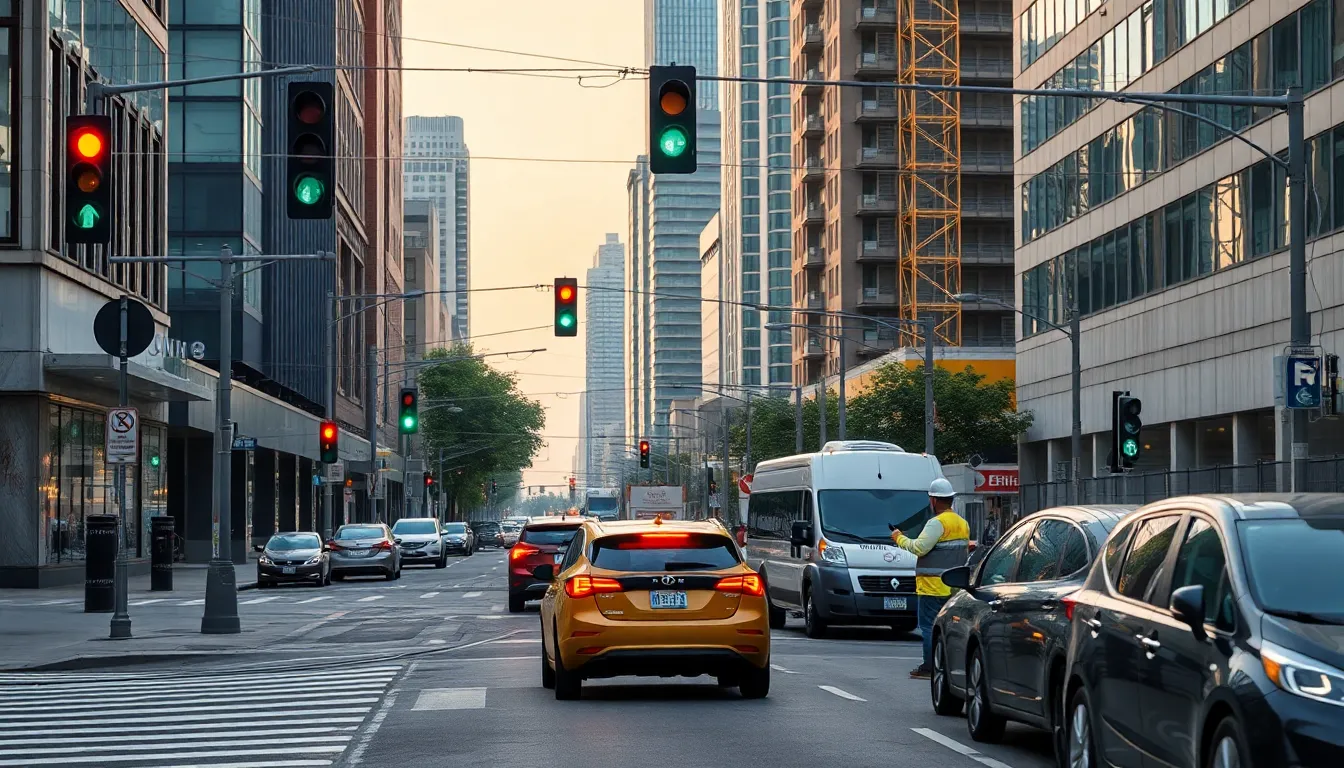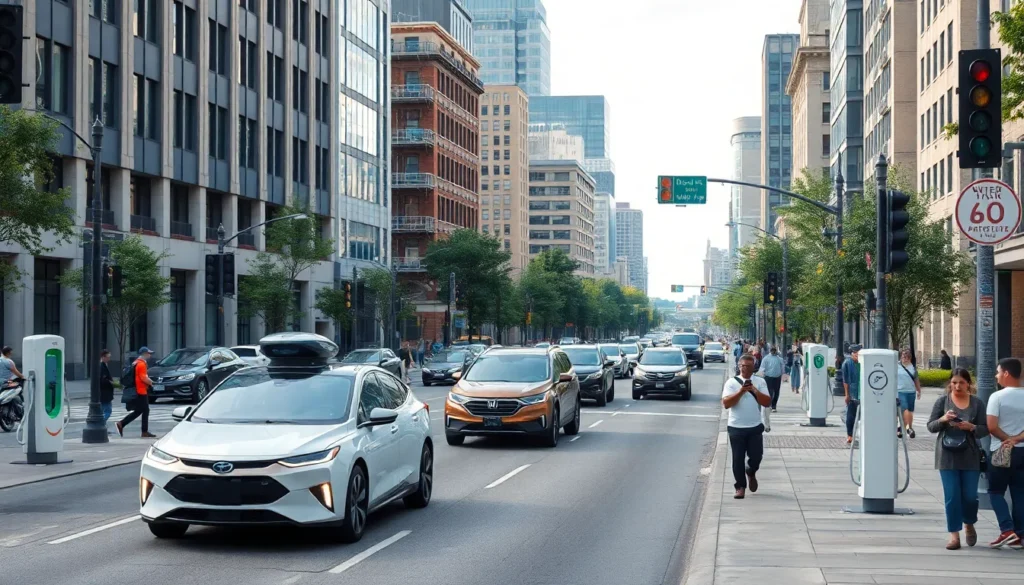Table of Contents
ToggleThe future of transport infrastructure is revving its engines, and it’s shaping up to be a wild ride. With technology zooming ahead faster than a kid on a sugar rush, cities are rethinking how we get around. Gone are the days of gridlock and potholes; instead, picture smart roads that practically drive themselves while you sip your morning coffee.
Overview of Transport Infrastructure Future
Urban mobility trends reveal significant changes in transport infrastructure. Advancements in technology streamline travel, impacting the way goods and people move. Smart roads leverage sensors and data analytics, enabling real-time traffic management. Autonomous vehicles enter the mainstream, providing safer, more efficient transportation options.
Infrastructure planning emphasizes sustainability. Electric vehicle charging stations become standard in urban areas. Investment in public transport systems, such as light rail and bus rapid transit, supports reduced greenhouse gas emissions. These systems enhance accessibility for all residents, promoting social equity.
Mobility as a Service (MaaS) platforms transform the transportation ecosystem. Users access various transport modes through a single application, simplifying trip planning and payments. Integration of bike-sharing and ride-hailing services promotes diverse transit options, elevating user experience.
Innovative materials and construction techniques contribute to more durable infrastructure. The adoption of self-healing concrete and recycled materials reduces maintenance costs. Green infrastructure practices, such as permeable pavements and green roofs, manage stormwater and improve urban resilience.
Data-driven decision-making shapes future projects. Cities leverage Geographic Information Systems to analyze traffic patterns and forecast infrastructure needs. Stakeholders, including government and private entities, collaborate to align transport strategies with evolving demands.
Ultimately, the future of transport infrastructure hinges on a blend of technology, sustainability, and user-centered design. The goal remains clear: to create integrated, efficient systems that meet the needs of growing urban populations while fostering a cleaner environment.
Emerging Technologies in Transport Infrastructure

Technological advancements play a crucial role in shaping the future of transport infrastructure. These innovations promote efficiency, safety, and sustainability within urban environments.
Smart Transportation Systems
Smart transportation systems leverage technology to enhance traffic management and improve overall mobility. Sensors embedded in roads collect real-time data on traffic flow, allowing cities to adjust signal timings dynamically. This responsiveness reduces congestion and minimizes delays. Additionally, integration with autonomous vehicles streamlines travel by providing seamless communication between infrastructure and vehicles. The implementation of smart traffic signals and connected vehicle technologies leads to fewer accidents, making urban travel safer. User experience improves as real-time updates reach drivers through mobile applications, facilitating informed route choices.
Sustainable Materials and Construction Techniques
Sustainable materials fundamentally change construction practices for transport infrastructure. Innovations such as self-healing concrete increase durability and decrease maintenance needs. The adoption of recycled materials contributes to lower environmental impacts while promoting resource efficiency. Investment in green construction techniques enhances the sustainability profile of projects and supports long-term ecological goals. These methods significantly reduce carbon footprints and align with broader climate change initiatives. Infrastructure projects increasingly incorporate stormwater management features, promoting resilience against climate-related challenges. Overall, these advancements create structures that prioritize ecological stewardship while meeting community needs.
Impacts of Climate Change on Transport Infrastructure
Climate change significantly affects transport infrastructure, resulting in challenges that require immediate attention. Infrastructure vulnerabilities arise from extreme weather events, rising sea levels, and increased temperatures.
Resilience and Adaptation Strategies
Resilience strategies involve upgrading existing infrastructure to withstand climate impacts. Training staff on emergency response and implementing regular assessments enhance readiness. Prioritizing investment in durable materials proves essential for longevity. Green infrastructure solutions, such as permeable pavements and green roofs, manage stormwater effectively. Community engagement in planning processes fosters robust adaptation plans.
Policy and Regulatory Considerations
Policy frameworks influence transport infrastructure development amid climate change. Regulation must prioritize sustainability and promote green technologies. Governments need to incentivize investments in climate-resilient infrastructure. Encouraging collaboration among stakeholders strengthens response strategies. Moreover, integrating climate considerations into urban planning ensures future transport systems meet environmental challenges.
Case Studies of Innovative Transport Infrastructure Projects
Innovative transport infrastructure projects illustrate the shift toward smarter, more sustainable urban mobility. Global examples showcase successful implementations worldwide.
Global Examples
Singapore’s Smart Traffic Management System utilizes real-time data to optimize traffic flow. This approach reduces congestion and enhances efficiency. In Amsterdam, the city’s extensive bike infrastructure promotes cycling, resulting in reduced vehicle emissions and improved public health. Furthermore, Los Angeles has invested in a light rail network that connects communities and encourages public transportation use, aiming to lessen dependence on cars. These cities demonstrate diverse strategies tailored to their unique transportation challenges and opportunities.
Lessons Learned for Future Projects
Successful projects highlight the importance of data-driven decision-making. Stakeholders need to engage early and consistently to ensure alignment with community needs. Implementation of innovative materials, such as recycled components, lowers long-term maintenance costs. Collaboration among government entities and private sectors fosters resilience in infrastructure planning. Lessons from climate adaptation reveal that prioritizing sustainability often leads to long-term benefits. Ongoing evaluations and feedback mechanisms enhance project outcomes, ensuring adaptability to future demands.
The future of transport infrastructure is poised for a remarkable transformation driven by technology and sustainability. As cities evolve and face new challenges, innovative solutions will play a crucial role in enhancing urban mobility.
Smart roads and autonomous vehicles are set to redefine how people and goods move, while the integration of Mobility as a Service platforms will simplify travel experiences.
A commitment to resilient and environmentally friendly infrastructure will ensure that urban areas can adapt to climate change challenges. Collaborative efforts among stakeholders will be essential in shaping a future that prioritizes efficiency, safety, and social equity.
With a focus on data-driven decision-making and innovative materials, the transport landscape will not only improve connectivity but also contribute to a healthier planet for future generations.







